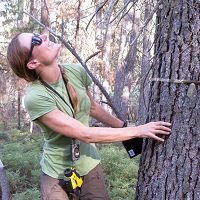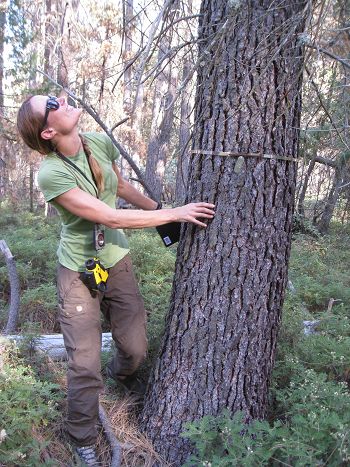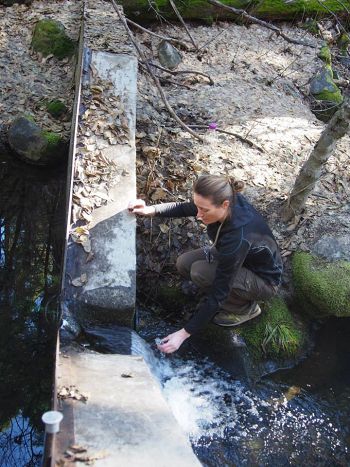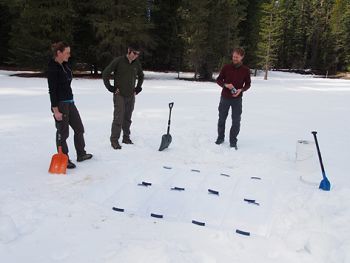Critical Zone Profile - MELISSA THAW (mountain hydrologist, PhD student)
Mountains are considered the world’s “water towers.” Runoff from the Sierra Nevada Mountains in California provides water resources to over half of the state’s population. Yet current methods of forecasting runoff based on snowpack are unreliable due to uncertainties in the water balance. Understanding how water moves from the subsurface and soil to the atmosphere is an important part of the mountain water balance.
Melissa Thaw will use isotopes as tracers to track water through the mountain system. These tracers will also allow Thaw to understand where trees get their water during drought conditions. By combining ground-based data with remote sensing techniques, Thaw will study the movement of water seasonally and across the landscape.
“In science research, the human context is super important. My experience working for an environmental non-profit at Lake Tahoe helped me to learn how to translate science to the public and into policy.” – Melissa Thaw
I was born and raised in the Sierra Nevada, at Lake Tahoe. Lake Tahoe is one of the most pristine and protected lakes in the world that is not a park or wilderness area. I grew up in the outdoors hiking, backpacking, canoeing, cross country skiing, and backcountry snowboarding. Over many years spent in the Sierra, I have seen normal climate variation, including long droughts, huge snowfalls in winter, and rain on snow events. I witnessed a catastrophic wildfire burn through forest and part of my community. I have also seen climate warming lead to increases in lake water temperatures (higher elevations are warming faster than lower elevations). I have seen invasive species become introduced. In all of these cases, ecology and hydrology have been intertwined.
Anthropogenic warming is increasing California’s drought risk and severity. Decreased snow water equivalent due to climate warming will likely lead to lower recharge and decreased base flow in the Sierra Nevada, while evapotranspiration is likely to increase. Evapotranspiration accounts for a large portion of the water balance, but it can be challenging to characterize in mountain environments due to heterogeneous topography, vegetation, and low-resolution meteorological information.
Globally, most forest species survive within narrow hydraulic constraints and are vulnerable to climate change-induced drought. Understanding vegetation drought vulnerability and the ecological feedbacks associated with vegetative water use is important in forest vegetation management strategies. I will be looking mainly at whether vegetation is using soil water or deeper sources such as bedrock water.
In addition to the water that plants use in the forest, soil evaporation is also an important part of the water cycle. Forest management practices have led to changes on the forest floor, likely affecting soil water storage. Characterizing the effects of litter and duff on soil evaporation in the Sierra Nevada will contribute to computerized hydrologic models that help us estimate where water is going in the system. By co-locating field experiments with high resolution soil moisture and temperature sensors, I will be able to contribute to our understanding of soil evaporation in montane environments.
The Southern Sierra CZO provides an excellent opportunity to study the rain-snow transition zone in the Sierra Nevada and how our water resources here will be affected by climate change. By holistically approaching this system, I can understand the cross-over between hydrology and forest ecology. This interdisciplinary research will allow us to understand important ecological feedbacks affecting mountain water resources.
The nature of interdisciplinary research requires fluency in many academic fields, including physics, ecology, hydrology, and chemistry. Field work can also be challenging physically. Persistence is key in both areas.
Taking preliminary snow samples for radioactive isotope analysis. We put the containers out to collect new snow in the next storm.
The Sierra provides an array of ecosystem services beyond clean water that include carbon sequestration, clean air, wildlife habitat, and recreation. By asking scientific questions that can improve management, we have the opportunity to conserve and increase the value of the ecosystem services the Sierra provides to the entire state. Returning the forest to its natural vegetation species and size composition, and using fire ecology appropriately to manage fuels, are two promising management strategies we can consider. Adaptive management will be key going forward, as our climate changes and the environment rapidly changes as a result.
:: By Linda Copman, staff writer ::
Melissa Thaw
Collecting stream water for stable isotope analysis. Photo by Erin Stacy.
Taking preliminary snow samples for radioactive isotope analysis. We put the containers out to collect new snow in the next storm.
News Category:
RESEARCH |
PEOPLE |
EDUCATION/OUTREACH
Related News
Explore Further








